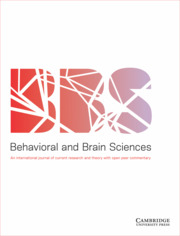Article contents
The economic origins of ultrasociality
Published online by Cambridge University Press: 27 April 2015
Abstract
Ultrasociality refers to the social organization of a few species, including humans and some social insects, having a complex division of labor, city-states, and an almost exclusive dependence on agriculture for subsistence. We argue that the driving forces in the evolution of these ultrasocial societies were economic. With the agricultural transition, species could directly produce their own food and this was such a competitive advantage that those species now dominate the planet. Once underway, this transition was propelled by the selection of within-species groups that could best capture the advantages of (1) actively managing the inputs to food production, (2) a more complex division of labor, and (3) increasing returns to larger scale and larger group size. Together these factors reoriented productive life and radically altered the structure of these societies. Once agriculture began, populations expanded as these economic drivers opened up new opportunities for the exploitation of resources and the active management of inputs to food production. With intensified group-level competition, larger populations and intensive resource exploitation became competitive advantages, and the “social conquest of Earth” was underway. Ultrasocial species came to dominate the earth's ecosystems. Ultrasociality also brought a loss of autonomy for individuals within the group. We argue that exploring the common causes and consequences of ultrasociality in humans and the social insects that adopted agriculture can provide fruitful insights into the evolution of complex human society.
Keywords
- Type
- Target Article
- Information
- Copyright
- Copyright © Cambridge University Press 2016
References
- 53
- Cited by




Target article
The economic origins of ultrasociality
Related commentaries (26)
Agriculture and the energy-complexity spiral
Agriculture increases individual fitness
Autonomy in ants and humans
Biological markets explain human ultrasociality
Contributions of family social structure to the development of ultrasociality in humans
Differences in autonomy of humans and ultrasocial insects
Differentiation of individual selves facilitates group-level benefits of ultrasociality
Does ultrasociality really exist – and is it the best predictor of human economic behaviors?
Human agricultural economy is, and likely always was, largely based on kinship – Why?
Human and ant social behavior should be compared in a very careful way to draw valid parallels
Humans are ultrasocial and emotional
Laying the foundation for evonomics
Malthus redux, and still blind in the same eye
On the effectiveness of multilevel selection
Rome was not built in one day: Underlying biological and cognitive factors responsible for the emergence of agriculture and ultrasociality
Social insects, merely a “fun house” mirror of human social evolution
The continuing evolution of ultrasocial economic organization
The convergent and divergent evolution of social-behavioral economics
The day of reckoning: Does human ultrasociality continue?
The similarity and difference between ant and human ultrasocieties: From the viewpoint of scaling laws
Ultrasociality and the division of cognitive labor
Ultrasociality and the sexual divisions of labor
Ultrasociality without group selection: Possible, reasonable, and likely
Ultrasociality, class, threat, and intentionality in human society
Ultrasociality: When institutions make a difference
“If it looks like a duck…” – why humans need to focus on different approaches than insects if we are to become efficiently and effectively ultrasocial
Author response
Disengaging from the ultrasocial economy: The challenge of directing evolutionary change